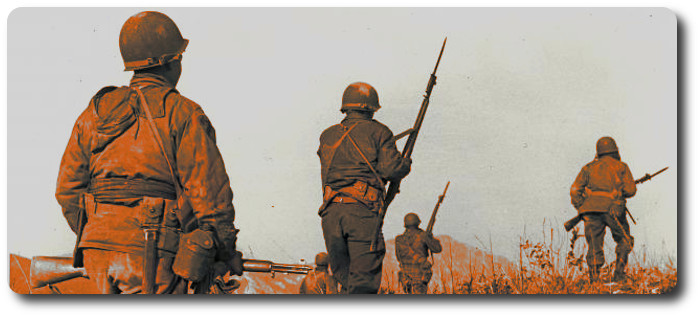
The Mobility of One Man (1949)
Colonel S.L.A. Marshall
Infantry Journal, Vol. LXV, No. 4, October, 1949
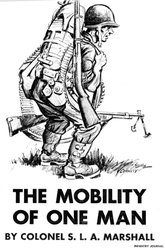 Toward the end of 1947 an official board of the Army of the United States, which had been appointed to study the overall nature of future war and estimate how the power the new weapons, including the atomic, would change the conditions of warfare and influence the character of armies, reached this conclusion: "Basic methods will not be materially different from those employed at the end of World War II. Forces will be organized and equipped for increased mobility and fire power."
Toward the end of 1947 an official board of the Army of the United States, which had been appointed to study the overall nature of future war and estimate how the power the new weapons, including the atomic, would change the conditions of warfare and influence the character of armies, reached this conclusion: "Basic methods will not be materially different from those employed at the end of World War II. Forces will be organized and equipped for increased mobility and fire power."
The hoard did not say how armies would achieve increased motility and fire power. That was not within the scope of its assignment. But believing with the board that the search for further mobility is a key to the future, it is my purpose to discuss a reform by which we can gain that end in part, at least so far as it pertains to foot forces. Nor would this be worth doing if I did not find grounds for believing absolutely that the mobility and fire power of foot forces will be as decisive in any war of the near future as they have ever been, and that it is a fatal blunder to discount the future role of the Army. Those who think to the contrary and who are ever ready to proclaim that we have turned a corner in warfare, and swear that all we have learned in the past is obsolete, should he challenged to prove by the record that their past judgments warrant respect for their current opinions.
We should rely on history and the principles of war. Partly because all I have to say here on mobility is related to the thought of an army from the highest commander to the lowest private, and partly because much of it is at variance with the methods of armies since time immemorial, it is necessary to present it From many points of view. I am not among those who believe that mobility comes primarily from the machines that give us speed and reliability. If that were all, we could turn the whole problem over to Ordnance and the Transportation Corps. With a greater machine capacity than any other nation, we of the US. would already possess the certain key to successful war.
But I think that in the military sense, mobility is only present when there is the will to fight. It is not simply traction and speed, but the ability to stand against fire and to deliver it, that finally gives virtue to mobility.
Mobility in the armies, therefore, is a matter of the mind and spirit rather than of technical equipment. It is having confidence in one's own resources and willingness to accept the life-and-death responsibilities of a fighting situation. Mobility, in an army or a battalion, is chiefly a reflection of its leadership. When a unit of any size whatever is truly tempered by patriotic indoctrination, efficient training and sound battle practice, its mass reaction will he to make the most perfect use of every vital opportunity. This quality is the true mobility of any military force. To say that a unit is less mobile on a given night because it is moving in rubber boats against a hostile shore, than on the next day when it is moving by jeep along a good road is to lose sight of the real concept of the mobility of armies.
What the machine has chiefly done for us in war is to reduce space by economizing time. In other words, the laster we move, the smaller becomes the area we are called on to defend or capture. In World War II, we were shown time and again that a handful or men at a certain spot at a given hour was a more powerful influence on the battle than ten times that number twenty-four hours later. By prompt and imaginative action, lone rifle companies sometimes diverted whole enemy army corps. And one machine-gun squad at a road block began the defeat of an armored division.
But though the machine, giving us greater cross-country speed, can effect a direct economy in numbers of men, it cannot reduce the requirements For courage and steadfastness in those who engage the enemy. The will to move forward and the willingness to light must now be as strong as in the days when all movement was so slow that whole armies could actually confront each other in mass. Time and the saving of time are more than ever the essence of successful operation. In fact, then, if we are to achieve greater effects with fewer men, it is indisputable that we must have better men.
For these reasons, inquiry into an improved mobility should begin with a better understanding of the whole nature of the soldier. What assists him and hardens his will? What stops him and strangles his best intentions? It is altogether conceivable that at this stage of history, we can achieve much faster movement by concentrating on these questions—and much more surely than we can do it by looking for a faster wheel or a more powerful engine.
Such a search raises questions of major concern to every part of the Army. Any new doctrine, if it is to be an improvement, must be acceptable alike to the fighting arms and the supply services. How the strategist, the tactician and the logistician, all three, react to it is, for the time being, more important than whether it is fully understood by the rank-and-file.
For it is only when the Army as a whole see the problem as a whole that there is hope for a true solution.
One-Man Logistics
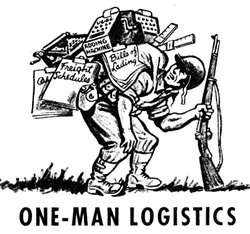 Strategy is the art of the general. And like any other art, it requires patience to work out its basic concepts. But the odd part of it is that among higher commanders that branch of the art most apt to be treated with a broad stroke, though it calls loudest for the sketching-in of minute details, is the logistics of war.
Strategy is the art of the general. And like any other art, it requires patience to work out its basic concepts. But the odd part of it is that among higher commanders that branch of the art most apt to be treated with a broad stroke, though it calls loudest for the sketching-in of minute details, is the logistics of war.
Since that word has in recent years become a catchall, covering everything pertaining to the administrative and supply establishments, it is necessary that I be exact as to how I use it here. Let us therefore take the definition of Sir George Colley, who described logistics as "the scientific combination of marches, the calculation of time and distances, and of economy of men's powers." This is much more satisfying than anything to be found in our own dictionaries.
But when that last phase is included (and it cannot be left out) it precludes that view of logistics which sees it only as a game for the (G-4s and the mathematicians—a game to be settled with loading tables, slide rules and transportation schedules.
Logistics becomes, in fact, the very core of generalship—the thing that is ever the main idea—to get military forces into a theater of war in superior strength and husband that strength until they shall prevail. Further than that, I think we can all agree this does not mean numbers of men and weapons solely. For if it did a general would be only a glorified cattle drover, and we would say of him what Col. G.F.R. Henderson wrote of General Pope: "As a tactician, he was incapable. As a strategist, he lacked imagination. He paid no attention to the physical wants of man or beast." With the general, as with anyone under that rank, the very acme of leadership comes of the ability to lift the powers of the average man in the ranks to the highest attainable level and hold them there. It is therefore especially curious that there is less competent military literature on this subject—the economy of the powers of fighting men—than on any other aspect of war.
In modern armies, more is being written about moral value than in the preceding nineteen centuries. Yet modern works on the art of command have almost nothing to say about the economy of men's powers. It seems to be taken for granted that the introduction of the machine into warfare is tending to produce automatic solutions of the prevailing problem of how to get more fire out of fewer men. But that can only be true if men's powers before and during battle are more carefully husbanded than they have ever been. The actual fact is that men in the mass are growing weaker. The general impact of the machine on all industrial populations is to lower the stamina of the individual and make it less likely that he will develop his legs by walking and harden his back and shoulder muscles by manual toil. Until recently the most sturdy and reliable soldiers were drawn from the agricultural population. Now the drafts are filled with men from towns and cities, more than half of whom have never taken regular exercise or participated in any group game. Likewise, the machine has tremendously increased the over-all weight of war. Two hundred years ago an army could go through a campaign with what it carried in its train and on the backs of its soldiers. But in the European Theater in the last war, every soldier had to have back of him some ten tons of materiel. And the field army that had to rely on its organic transport during an extended advance found itself soon beached high and dry.
So much for change in one direction. The machine has made warfare more ponderous but has also given it greater velocity. In the other direction there has been no change at all. For it is conspicuous that what the machine has failed to do right up to the present moment is decrease by a single pound the weight the individual has to carry in war. He is still as heavily burdened as the soldier of 1000 years BC.
This load is the greatest of all drags upon mobility in combat and I submit that it is not due to unalterable circumstance. It comes mainly of the failure of armies and those who control their doctrine to look into the problem. A decisive decrease in that load is possible, once we recognize that our use of the machine can be accommodated to this end. Failing that, we will not in the future make the best use of our human material.
Nothing benefits an army, or any part of it, which is not for the good of the individual at the hour he enters battle. For that reason, the whole logistical frame of the Army of the United States should develop around an applied study of the logistical capability of one average American soldier.
That means getting a more accurate measure of his physical and moral limitations, and of the subtle connection between these two sides of his being. It means rejecting the old dogmatic notion that by military training alone we can transform the American soldier into a cross between Superman and Buck Rogers. It means that by first enlightening ourselves, we have the main chance to bring forth the soldier more enlightened.
The Dead Hand
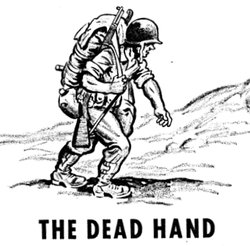 Gen. J.F.C. Fuller once said that adherence to dogma has destroyed more armies and lost more battles and lives than anything else in war. I believe this can be proved to the hilt, and that it is time to shake it. For in the future we will not be able to afford any unnecessary expenditure.
Gen. J.F.C. Fuller once said that adherence to dogma has destroyed more armies and lost more battles and lives than anything else in war. I believe this can be proved to the hilt, and that it is time to shake it. For in the future we will not be able to afford any unnecessary expenditure.
In the study called Men Against fire I dealt somewhat narrowly with the problem of conserving the average man's power on the battlefield. The main theme was that the reason all movements in minor tactics tend to fall apart is that we have not rooted our tactical thinking in a sound appreciation of how the average American thinks and reacts when hostile fire comes at him.
But the case as presented there was too limited. It considered man only as a being who can think—who gathers moral strength from his close comrades—who needs every possible encouragement from them if he is to make clear decisions and take constructive action in the face of enemy fire.
But something should be added. On the field of battle man is not only a thinking animal, he is a beast of burden. He is given great weights to carry. But unlike the mule, the jeep, or any other carrier, his chief function in war does not begin until the time he delivers that burden to the appointed ground.
It is this distinction which makes all the difference. For it means that the logistical limits of this human carrier should not be measured in terms of how much cargo he can haul without permanent injury to bone and muscle, but of what he can endure without critical, and not more than temporary, impairment of his mental and moral powers. If he is to achieve military success and personal survival his superiors must respect not only his intelligence but also the delicate organization of his nervous system. When they do not do so, they violate the basic principle of war, which is conservation of force. And through their mistaken ideas of mobility they achieve only its opposite.
Almost 150 years ago, Robert Jackson, then inspector general of hospitals in the British Army, put the matter thus simply: "To produce united action of bodily power and sympathy of moral affections is the legitimate object of the tactician." The desired objective could not be stated more clearly today. It is universally recognized that the secret of successful war lies in keeping men in a condition of mental alertness and physical well-being which insures that they can and will move when given a competent order.
Yes indeed! Everybody is ready to give three cheers for mobility. But when it comes to the application of the principle at the most vital point of all—the back of the soldier going into battle—the modern commander is just as liable to be wrong about it as the father of the general stall, General Scharnhorst, when he wrote these incredible words: "The infantryman should carry an axe in case he may have to break down a door."
Scharnhorst did not lack for company. You cannot read far into war without noting that among the great leaders of the past there has been a besetting blindness toward this subject. Either they have not deemed it worth mentioning among the vital principles of command, or their thoughts about it were badly confused.
Take Marshal Maurice de Saxe for example since his grasp of moral problems was on the whole profound. About training he wrote eloquent truths like this one, "All the mystery of combat is in the legs and it is to the legs that we should apply ourselves." But when de Saxe turned his thoughts to the problem of man's powers on the battlefield, he said: "It is needless to fear overloading the infantry soldier with arms. This will make him more steady."
Making all allowances for the more limited movements during battle and the short killing range of all weapons during the wars of de Saxe's times, it must still be conceded that on this point he sounds like an ass. Overloading has never steadied any man or made him more courageous. And such dictum runs directly counter to the principles of war and the sound leading of soldiers.
But the words are dangerous, if only because de Saxe uttered them. We too often ascribe to successful men a godlike infallibility, instead of weighing all things in the light of reason. What the Great Captains thought, succeeding generations find it difficult to forget and challenge reluctantly despite an ever-broadening human experience.
We are still troubled by commanders who do not "fear overloading the infantry soldier with arms." Rare indeed is the high commander who will fight consistently and effectively for the opposite. In fact, it is chiefly the high commanders who have laid this curse on the back of the fighting man right down through the ages. The second lieutenants have usually known better.
Take Frederick the Great. He said that a soldier should always carry three days' food. Take Napoleon. He said on St. Helena that there are five things a soldier should never be without, "his musket, his cartridge box, his knapsack, his provisions for at least four days and his pioneer hatchet." Take Scharnhorst again. He said that a soldier should carry with him, besides his arms and a three-day supply of bread, "sixty rounds of ammunition, three spare flints, a priming wire, a sponge, a worm, an instrument for taking the lock to pieces, two shirts, two pairs of stockings, rags to wrap up his feet on a march, combs, brushes, pipe-clay, black balls, needles and thread."
We can forget such details as the "worm" and the "sponge." The point is that what a soldier is required to carry into battle today is more directly related to these hoary prescriptions than to any modern survey or analysis showing what a soldier is likely to use most in combat—and what weights he could well be spared by a more foresightful planning for the rise of other forms of transport.
In fact, careful research, after first revealing the historic roots of most of these elementary logistical concepts would also enable us to trace their growth right down to the present. But the researcher would look in vain for proof that they are based upon field data rather than upon a blind adherence to tradition. He would perforce conclude with Bacon that: "The logic now in use serves rather to fix and give stability to the errors which have their foundations in commonly received notions than to help the search for truth!"
Perhaps in Frederick's day it was necessary for a soldier to carry three days' food in his pack. Maybe when Napoleon was on the march there was a sound reason for upping that figure from three to four. One can even give Stonewall Jackson the benefit of the doubt for following Frederick's rule-of-thumb during his campaigns in the Valley. Though observers noted, according to Col Henderson, that it was the habit of the troops to bolt their three rations as soon as possible and then scrounge around for more.
But why in common sense during World War II did we put infantrymen across defended beaches carrying three full rations in their packs? In other words, nine packages of K rations, weighing roughly the same number of pounds! We did it time and again in landings where "hot cargo" shipments of food were coming onto the beaches right behind the troops and almost tripping on their heels.
One package would always have been enough—one-third of a ration. In fact, we learned by actual survey on the battlefield that only some three per cent of the men along the combat line touched any food at all in the first day's fighting. And that water consumption was only a fifth what it became on the second day and thereafter. Such is the economy that can he achieved by virtue of a churning stomach.
But compared to this reality, we continued until the end of the war to overload our forces with food every time we staged a major attack. To understand why we did it, we must disregard field data and look into history. Some centuries ago Frederick had an idea.
The Fire Load
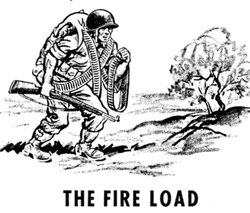 A more critical and debatable issue than the amount of rations to be carried is the weight of the fire load, since fire is the mainspring of mobility and men can't shoot with empty guns. Again the historical roots of the solution are worth remarking.
A more critical and debatable issue than the amount of rations to be carried is the weight of the fire load, since fire is the mainspring of mobility and men can't shoot with empty guns. Again the historical roots of the solution are worth remarking.
Outdoing Scharnhorst, von Moltke in his time decided that 200 rounds of ammunition was a more fitting load for the sturdy Prussian. That became the standard requirement for modern armies. Both sides used it during the Russo-Japanese War, and most armies likewise used it in World War I. So far as may now be learned, no one of any importance saw fit to question whether that figure of 200 rounds had any justification, either in tactics or logistics. In the American Army in France of 1917-18, our commanders usually adhered to the practice of requiring troops to carry a full ammunition load during the approach march, even in moving into a "quiet" sector. And in hot weather the results were brutal. We can write of the general policy with the simple statement that troops usually had to carry ten times as many cartridges as there was any likelihood they would use.
Following World War I, several general staffs, and particularly the French, gave some thought to the proposal that with the improvement of first-line transport through motorization it had become possible to relieve the soldier of carrying his own ammunition reserve. But these good intentions bore no tangible fruit, though in the course of World War I such weapons and equipments as the grenade, trench knife and gas mask had been added to the soldier's over-all weight.
When World War II came along, the rule-of-thumb laid down almost a century before by Moltke still gave the infantryman blisters around his belly, though meanwhile, owing to changes in civilian transportation, the system of forward supply had undergone a transformation so revolutionary that it had become almost impossible for the combat line to run out of ammunition. Jeeps and amtracs were carrying the stuff right up to the company CPs and on to the firing line. And when they couldn't go fast enough, planes were dropping it there in bundles.
Despite this altered situation there was no relief for the human carrier. True enough, we did not follow the Moltke prescription right down to the last cartridge. But we deviated from it, not primarily to lighten the soldier's load but to make room for other types of ammunition.
For example, during the last two years of operations in the Pacific, the rifleman put across a beach generally carried eighty rounds for his M1 or carbine. This special dispensation was simply granted him that he might the better carry eight hand grenades, or in some cases five. It was presumed that in the close-in fighting he was likely to meet, five to eight grenades would give him a wider margin of safety than double the amount of his rifle ammunition.
In the event, such calculations were found to have little practical relation to what took place along the line of fire. When you examined company operations in atoll fighting in detail, it was evident that the soldier who used grenades at all was almost as rare as the man who fired as many as eighty rounds from his rifle in any one day of action. Which is to say that the load of grenades the line was required to carry did not promote either increased safety or greater fire power. Eight grenades are a particularly cumbersome burden. They weigh 10.48 pounds. Had the grenade load of each man been cut by three-quarters (giving him two grenades) it is a reasonable assumption that the over-all and expedient tactical use of that weapon would not have been reduced, and the force so lightened would not have been made more vulnerable.
With all hands carrying eight grenades, the number of men making any use of that weapon at all was consistently less than six per cent of the total in any general action. Research showed further that the grenade was rarely put to any practical use in the initial stage of an amphibious attack. This was also true in Europe.
Having been a grenadier in the Army before I became qualified at anything else, I have a natural sentimental fondness for the grenade. In the first World War, I was convinced that the throw as taught was bad for American practice, and therefore conducted the first experiments that resulted in its change. But at that time I learned that if the weapon is to be employed usefully, it must be understood that a definite penalty is attached to over-estimating its usefulness. That still applies. The high command falls into such an error when it overloads the man. The soldier himself makes the error—as we learned in too many cases—when he uses the grenade to clean out the unseen interiors of such places as underground air-raid shelters and thick-walled blockhouses, and then takes it for granted the job is tactically finished.
I agree that there are conditions of terrain, and situations that involve movement through entrenchments or against houses, where the grenade is all but indispensable. But common sense says also that if it is mobility we want, there is no more justification for loading men with grenades they are not likely to use than to send them forward burdened with so many sticks and stones. In fact, that might be better, for they would then drop off their ballast at the earliest possible moment.
This same argument would eliminate altogether any further issuing of the bayonet. That weapon ceased to have any major tactical value at about the time the inaccurate and short-range musket was displaced by the rifle. But we have stubbornly clung to it—partly because of tradition which makes it inevitable that all military habits die a slow death, but chiefly because of the superstition that the bayonet makes troops fierce and audacious, and therefore more likely to close with the enemy.
I doubt that any combat officer of the last war below field grade would agree that this idea has any merit whatever. Their observations are to be trusted more than the most positive opinions of any senior commander who has had no recent experience with infighting.
The bayonet is not a chemical agent. The mere possession of it will not make men one whit more intrepid than they are by nature. Nor will any amount of bayonet training have such an effect. All that may be said of such training is that, like the old Butts Manual, its values derive only from the physical exercise. It conditions the mind only in the degree that it hardens the muscles and improves health.
The bayonet needs now to he re-evaluated by our Army solely on what it represents as an instrument for killing and protection. That should be done in accordance with the record, and without the slightest sentiment. So considered, the bayonet will be as difficult to justify as the type of slingshot with which David slew Goliath. A situation arose during the siege of Brest in August 1944, when the 29th Infantry Division found that an improvised slingshot was useful in harassing the enemy. And about all that may be said for the bayonet, too, is that there is always a chance of its being used to advantage. But the record shows that that chance is extremely slight.
In the Pacific fighting of World War II, more men were run through by swords than by bayonets.
In our European fighting there is only one bayonet charge of record. That was the attack by the 3d Battalion, 502d Parachute Infantry, at the Pommerague Farm during the advance on Carentan, France, in June 1944. In that attack three of the enemy were actually killed by American bayonets. It is a small irony, however, that these killings took place about six minutes after the main charge had subsided. And it is a somewhat larger irony that the one junior officer who actually closed with the bayonet and thrust his weapon home was subsequently relieved because he was not sufficiently bold in leading his troops.
Airborne Example
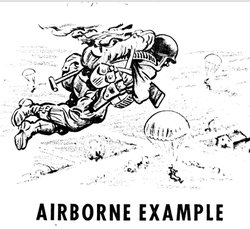 Since we are talking about mobility, and how to control the loading of the soldier toward that end, there is no chapter from our past more instructive than our airborne operations of World War II.
Since we are talking about mobility, and how to control the loading of the soldier toward that end, there is no chapter from our past more instructive than our airborne operations of World War II.
In the European Theater, the basic individual ammunition load for the paratrooper was eighty rounds for his carbine or MI, and two hand grenades. When the paratrooper jumped into Normandy on June 6, 1944, he also carried these things: 1 rifle and carrier part, 1 English mine, 6 packages of K-ration, 1 impregnated jump suit, 1 complete uniform, 1 steel helmet and liner, 1 knitted cap, 1 change of underwear, 2 changes of sox, 1 entrenching tool, 1 gas mask, 1 first-aid pack, 1 spoon, 2 gas pro tective covers, 1 field bag with suspenders, 1 packet of sulfa tablets, 1 escape kit, and a set of toilet articles.
Despite all that weight, the most salient characteristic in operations by these forces was without doubt the high mobility of all ranks. That was because most of them used common sense. They jumped heavy but they moved light. Once on the ground, most of them ditched every piece of equipment they considered unnecessary. They did this without order, and often before they had engaged any of the enemy or joined up with any of their comrades. It was a reflex to a course of training which had stressed that the main thing was to keep going.
The mainspring to the movement of these forces lay in the spirit of the men. They moved and hit like light infantry, and what they achieved in surprise more than compensated for what they lacked in fire power.
Further, at every point they pressed the fight hard, and the volume of fire over the whole operation proved to be tactically adequate, though supply remained generally adverse.
The 82d and 101st Divisions jumped into one situation where for two days all their elements were engaged by the enemy and only those groups fighting close to Utah Beach had an assured flow of ammunition. Some of the groups got additional ammunition from bundles dropped either by the initial lift or by resupply missions But until the airborne front was passed through by the seaborne forces, many of these riflemen were completely dependent on the ammunition they had jumped into Normandy with—eighty rounds and two grenades.
Yet in the whole show, covering the five days of operation down to the crossing of the Merderet by the 82d and the capture of Carentan by the 101st, there is only one instance of a detachment having to yield ground temporarily because it ran short of ammunition. That happened at Le Port Bridge near the mouth of the Douve River where for three days 84 men of the 506th Parachute lnfantrv, under Capt. Charles G. Shettle, made one of the most courageous stands of the invasion. Their stand had the greatest strategic consequence, since this was the bridgehead where V and VII Corps were to ultimately link.
In the beginning Shettle's group survived without any loss of morale the temporary embarrassment caused by lack of ammunition. They simply fell back to the near side of the bridge. In the end they retrieved another ammunition bundle or two and recovered the lost ground.
All that happened to Shettle and his men deserves to be taken at face value. If, act by act, we could weigh out our whole infantry experience from the last war, we would discover a frequent repetition of the lesson of this small incident.
The moral is that we spend a great part of our time worrying about the wrong things.
Fundamentally there are two reasons for the chronic tendency to load the soldier down with too much ammunition rather than take the opposite chance.
No. 1 is the belief that it is good for his battle morale that he is less likely to fight vigorously if harassed by the thought that his ammunition is running short.
This is a psychological fallacy. Soldiers' minds simply do not work that way.
The willing fighter will spend his last round if convinced that the tactical situation requires it. And he will then look around to see where he can get some more ammunition.
No. 2 is the equally fallacious belief that ammunition shortages have often been a cause of tactical disarrangement in past wars, and are therefore to be avoided at all costs. It is hard to prove historically that this is untrue, because the history of all past wars becomes pretty blurred when it attempts to focus on the firing line.
But the closer we look at the details of the fire fight in World War II, the clearer it becomes that in the conditions of modern warfare, defeat because of an ammunition shortage is among the things least likely to happen. The mobility of supply and the reticulation of communications make it a minimum hazard. Further, there are always reserves at hand. The soldier who is always willing and eager to use his weapons has a reserve in the duty belt of the man next him who will go along into battle but will not fire. Likewise, the hard-pressed unit has an ammunition reserve on one or both of its flanks, since pressure is never distributed evenly along the length of a front and it is a responsibility of the less heavily engaged to make their supply available to the forces carrying the fight.
Possibly these ideas appear theoretical and impractical. The fact remains that some of our most creditable operations have been sustained in just this manner. The principle of borrowing and sharing kept the defense alive during the defense of Bastogne. The defense, during the "eight days" of the encirclement, was on short supply for nearly all weapons. And all concerned knew it.
And though Brig. Gen. Anthony C. McAuliffe kept banging on VIII Corps' door and repeating that his lines were in danger of being overrun because of his ammunition shortage (a condition gradually eased by resupply missions) there was no operation of the last war in which American troops fought with higher morale and confidence. The marches were not pushed the less forcefully because many men were weaponless and munitionless until they were within a mile or two of the enemy. The action of the artillery was not less intrepid and decisive because the guns were down to ten or twelve rounds per day. We miss some of the most important implications of Bastogne if we fail to weigh these facts in proportion and relate them to the largest problems of operating field forces with maximum economy.
To save the bone and muscle of soldiers toward the preservation of their fighting powers is probably as desirable an object as any we can seek to give us greater efficiency in the future.
But we have scarcely begun to move in that direction. There is still no general awareness that the human car rier, like his former army mate, the mule, has a logistical limit, which if exceeded, will inevitably cause a loss of supply and mobility, and may produce complete breakdown.
In fact we have always done better by a mule than by a man. We were careful not to load the mule with more than a third his own weight. And the mule, so far as we know, was never a bundle of nerves. Unlike man, he never reacted to battle as did Belshazzar to the writing on the wall "so that the joints of his loins were loosed and his knees smote one against the other."
The problem, and the conditions that call for a modern solution of it, were imaginatively stated to me by Gen. J.F.C. Fuller in a recent letter: "The soldier cannot be a fighter and a pack animal at one and the same time, any more than a field piece can be a gun and a supply vehicle combined. The idea is wrong at the start. Yet it is always being repeated.
"Fundamentally only two great novelties have come out of recent warfare. They are: (1) mechanical vehicles, which relieve the soldier of equipment hitherto carried by him; (2) air supply, which relieves the vehicle of the road.
"Machine guns are only quick fire and the atomic bomb is only a big bang—both are new only in quantity power and effect. But the above two novelties are of a new quality altogether so far as supply is concerned. It was only toward the end of World War II that the possible impact of these developments on future warfare was conclusively revealed."
The Way of Wastage
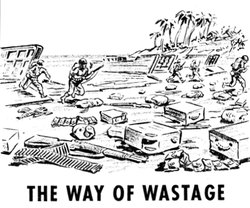 To refresh our minds on certain of the portents of World War II, we might also think back to the beachheads. What is the lasting impression?
To refresh our minds on certain of the portents of World War II, we might also think back to the beachheads. What is the lasting impression?
A scene of terrible litter, in which waste is even more apparent than confusion. The disorder is heightened by the presence of the dead and the waiting wounded. The loosely assembled supply dumps while they are forming always look as if a great storm had just passed through.
But to the eye trained to see through this seeming chaos and note the beginnings of a system, these things are routine. They will be there in any buildup in the face of the enemy. The more dismaying spectacle is the wastage of personal supply, the vast amount of packs, weapons and ammunition tossed away by troops already moving inland in search of the enemy.
There is nothing new or novel in these sights. You saw the same kind of wastage on the field of World War I, particularly in the Argonne where the pressure was almost unremitting. Eyewitnesses reported it of Gettysburg, saying, too, that of the thousands of rifles thrown away by soldiers, by far the greater number had never been fired. Of Cold Harbor, one witness reported: "Seeing what had been thrown away, I wondered how the battle had been fought." Probably there is no other characteristic more common to all the fields on which armies have contended than this one—inexplicable waste of essential equipment.
Yet it is strangely the fact that little thought has been directed toward this aspect of war by anyone, other than simply to note that it happens. The omission may be partly due to the circumstance that we conclude too easily that we cannot control it. At the top, where there are relatively few men who have ever carried sixty-five pounds into combat, there is a disposition to charge off this kind of wastage, saying that it is part of wars necessary expense, caused largely by the men in the ranks who are duty shirkers by nature.
While there is some substance for this belief, it is still only a segment of a large and more disturbing truth. So long as we continue to tell troops that mobility is in dispensable to success in battle, and preach that "safety lies forward," the most willing man who ever wore a soldier suit will discard a weight he finds he cannot carry under the extraordinary stresses of battle. If, in addition to being willing, he is also intelligent, he will make that decision at once when the moment arrives that his only alternative is to surrender to his own physical weakness and quit the light.
But this is one of the hardest decisions the dutiful soldier is ever called on to make. It is so for the reason that by the time the decision becomes necessary, his physical condition is likely to be such that he cannot think clearly. Many will say, I know, looking back to their own experience in battle, that troops learned automatically to discard the things they did not need, and that therefore there is no problem. That may be true. But they only gained this kind of wisdom by hard experience, and it is invariably in the first battle that the greatest damage is done. About three-fourths of our combat fatigue cases were broken the first time the went into action.
If those who have thoroughly observed the nature of the battlefield cannot accept the thought that the derelict soldier is alone the great waster of materiel, then it must follow that the fault lies rearward. That the troops are the victims of bad loading and faulty estimates of the relationship of loading to soundness in tactics. When troops do not perform as expected there is always a good reason, and to charge it to human slothfulness is itself slothful thinking.
There can be true economy of men's powers in war only when command reckons with man as he is and not as it would like him to be.
That, then, is the root of the difficulty. At planning levels there has always been a general ignorance of the logistical limits of the human carrier under fire, and of the drag on tactics which comes of weighting him too heavily.
History of the Problem
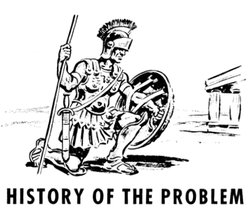 What is needed is a modern cure for a problem as ancient as the history of war. The historical antecedents have been well set forth by the Hygiene Advisory Committee of the British Army. which in the 1920's researched the subject of how soldiers have been loaded through the centuries, and published its findings in a pamphlet called The Load Carried by the Soldier. J.F.C. Fuller was a member of that commission, and it was from discussing the subject with him at about the time our forces went into Normandy that my attention was first drawn forcibly to the problem.
What is needed is a modern cure for a problem as ancient as the history of war. The historical antecedents have been well set forth by the Hygiene Advisory Committee of the British Army. which in the 1920's researched the subject of how soldiers have been loaded through the centuries, and published its findings in a pamphlet called The Load Carried by the Soldier. J.F.C. Fuller was a member of that commission, and it was from discussing the subject with him at about the time our forces went into Normandy that my attention was first drawn forcibly to the problem.
The work of the commission was scholarly though unimaginative. Other than establishing the direct connection between the excessive weights men carry in war and the high incidence of heart disease, kidney complaints, ailments of the circulatory system and the lungs, and augmented blood pressure among veterans, it drew no medical conclusions. It did not trace a connection between overloading and mental and physical collapse in battle. The report was not refreshed by combat data from World War I which would have contributed to knowledge of the psycho-organie changes occurring in men under lire as the consequence of being too heavily weighted. It is probable that no such information was available to the British Army, or to any other at that time.
There are many areas of combat knowledge we have hardly begun to explore, and we are informed least of all about the nature of the. combat line.
But what the commission did show clearly was that generals in all ages have been no respecters of the limitations of the human animal, either in or out of combat. In this they have been consistent, from Marcus Aurelius down to Marshal Montgomery. The Roman legionary, recruited usually at twenty and selected from the peasantry on a basis of sturdy strength rather than height, carried eighty pounds on his body when he went marching on the smooth Roman roads.
Though that seems brutal, we should at least add the footnote that 2,000 years after the Legion, the American Army dropped men from Higgins boats and onto the tough deep sands of Normandy carrying more than eighty pounds.
The French soldier at the time of the Crimean War carried an equipment of seventy-two pounds. The British Redcoats carried eighty pounds when they stormed our Bunker Hill. At Waterloo British infantrymen carried sixty to seventy pounds, the French about fifty-five.
Our infantry carried weights comparable to these during World War I. Conditioning soldiers to march with the heavy pack (about sixty pounds) was a training requirement. In combat more rations and munitions were added and very little of the training load was eliminated, at least by official order.
The commission found that with few exceptions, the armies of the past had honored the principle that lightness of foot in the individual produced buoyancy in the attack more in the breach than the observance.
Philip of Macedon was a notable exception. He achieved his mobility around a light infantry—the hypaspistes.
Oliver Cromwell made his Roundheads fast of foot by reducing their equipment to less than forty pounds.
Stonewall Jackson created an infantry which manoeuvred fast by keeping the individual working load to a minimum. His men did not carry extra clothing, overcoats or knapsacks. They marched with rifles, ammunition and enough food to keep going. Each man carried one blanket or rubber sheet; he slept with a comrade for extra warmth. The cooking was done at a common mess with frying pans and skillets. The skillet handle was spiked so that on the march it could be stuck in a rifle barrel.
The commission found that in general, armies through the past 3,000 years have issued equipment to the soldier averaging between fifty-five and sixty pounds, and have tried to condition him to that weight by long marching.
Finally, it reached the absolute conclusion that not in excess of forty to forty-five pounds was a tolerable load for an average-sized man on a road march. More specifically, it stated that on the march, for training purposes, the optimum load, including clothing and personal belongings, is one-third of body weight. Above that figure the cost of carrying the load rises disproportionately to the actual increment of weight.
These were the main points. However, the commission mildly suggested that there might be a radical difference between the weight-carrying ability of a soldier on a march, where he is thinking only of putting one foot in front of the other, and his limits in a fight—where his life depends on his quick wit. It raised an eyebrow at the military thinkers for never having given serious consideration to that probability.
Necessarily then, we must go on beyond the commission's work, if there is to be any better conclusion than that simply because the Romans and Hoplites did it, it is good enough for us today.
Fears of the Staff
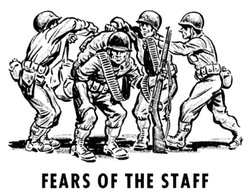 If a young and inexperienced company commander is ignorant about what happens to men so heavily loaded they have no fair chance for movement and survival in combat, he will not ruin the army. The prob ability is that he will not even hurt his own company. Some higher-up, with a slightly wiser head, will straighten him out.
If a young and inexperienced company commander is ignorant about what happens to men so heavily loaded they have no fair chance for movement and survival in combat, he will not ruin the army. The prob ability is that he will not even hurt his own company. Some higher-up, with a slightly wiser head, will straighten him out.
But when a staff is ignorant on this subject, then woe to the fighting line! The damage will not be undone. for a price will certainly be paid. This truth was repeatedly proved during World War II. We killed men unnecessarily because of our faulty appreciation of this.
The staff tended always to load the combat soldier according to its own view of every possible emergency that might confront him. With every member of a staff trying hard to think of every possible contingency, and no one above the staff enforcing a rigid weight limit to protect the soldier's back, the loads frequently became unsupportable.
With what results? The excess weights were simply not moved forward, mobile fire power was smothered. The combat line faltered and sometimes foundered under bangalore topedoes that were never exploded, gas equipment that was never used and ropes for scaling that might have proved useful had the battalion landed next to a cliff. The inertia thus begun was increased farther down the line by commanders who permitted their men to be killed with kindness instead of firmly insisting that they make the weight required for the contest.
These twin evils were subject to control. Our tactical power and general battle efficiency could have been increased had we:
(1) Established an absolute weight limit for men in combat.
(2) Enforced it by a rigid system of inspection.
We did neither. In this one particular, we acted less wisely than the ancient Scots who at Bannockburn went into battle with each fighting man feeling as light as air because his weapon had been carried up to battle by a porter. (It is of record that the battle turned on this fact. The English saw the mob of porters moving over Gillies Hill, mistook it for a fresh reinforcing army, and fled the field.)
Lessons from Omaha
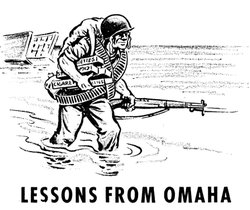 In the initial assault waves at Omaha Beachhead there were companies whose men started ashore, each with four cartons of cigarettes in his pack—as if the object of operations was trading with the French. Some never made the shore because of the cigarettes. They dropped into deep holes during the wade-in, or they fell into the tide nicked by a bullet. Then they soaked up so much weight they could not rise again. They drowned. Some were carried out to sea but the greater number were cast up on the beach. It impressed the survivors unforgettany—that line of dead men along the sands, many of whom had received but trifling wounds. One man said of this sight: "They looked like wax: I thought of Madame Tussaud's."
In the initial assault waves at Omaha Beachhead there were companies whose men started ashore, each with four cartons of cigarettes in his pack—as if the object of operations was trading with the French. Some never made the shore because of the cigarettes. They dropped into deep holes during the wade-in, or they fell into the tide nicked by a bullet. Then they soaked up so much weight they could not rise again. They drowned. Some were carried out to sea but the greater number were cast up on the beach. It impressed the survivors unforgettany—that line of dead men along the sands, many of whom had received but trifling wounds. One man said of this sight: "They looked like wax: I thought of Madame Tussaud's."
There are no final death statistics on Omaha. If any are in time published, they will be at best a rough approximation. No one can say with authority whether more men died directly from enemy fire than perished because of the excess weight that made them easy Victims of the water.
But when I had concluded my work with the survivors of the Companies which had landed during the initial Omaha assault, the impression was inescapable that weight and water—directly or indirectly—were the cause of the greater part of our losses at the beach.
Believing that this was the great lesson of the Omaha operation, and that it was more strongly illuminated there than in other landings during World War II be cause of the decisiveness of that operation and the numbers engaged, I feel that the tactical facts deserve even closer scrutiny than those questions of higher strategy on which we differed with the British or among our selves.
The fundamental error was a simple one. We overestimated the physical strength of men in the conditions of combat. This almost cost us the beachhead. Since it is the same kind of mistake that armies and their commanders have been making for centuries, there is every reason to believe it will happen again.
The mistake can be blamed only in part on the staff. In war our treatment of any basic problem reflects in large measure our thinking on the same problem during peace. It was so in this case. The general correctives needed could only have been applied by concrete thinking on the problem well in advance of war.
The root of the trouble lies here. We do lip service to the principle that the aim in logistics is not simply to support and supply the men on the fire line, but to relieve them of all unnecessary strain and tension. But it is lip service only.
We are reluctant to believe absolutely that 5,000 relatively fresh fighting men will defeat 15,000 worn-out men in the opposing line any day in the week.
In the hour of decision, the strength of an army cannot be counted in bodies but in the numbers of men who are spiritually willing and physically able to pick up and move on forward fighting.
At Omaha Beachhead our count of such men was extremely low. Certainly fear of death played a part in the paralysis of some of the men who couldn't get over the sands. However, we would be selling short our own human material, and would once again be guilty of gross ignorance about the underlying causes of terror among men who fight, if we took it for granted that the only reason so many men collapsed at Omaha was because they had to go through bullet and shell fire once they hit the shore.
To say that they would all have made it had they landed on a dry run exercise doesn't mean a thing.
Eyewitness Account
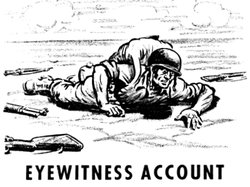 On D-DAY, Capt. Richard F. Bush landed with the assault waves at Omaha Beach. He was a field artilleryman. He went in on the same mission as the late Lieut. Col. "Moon" Mullins, one of the immortals of that great undertaking. Their task was to prepare the way for the landing of their own guns. But the guns didn't arrive. Again, someone's excess caution defeated the end in view. The guns were to be brought in on DUKWs. But somebody decided that the DUKWs and their cargo would be vulnerable to fire from the shore. So each DUKW was protected with a rampart of eighteen sandbags. Between this weight and the roughness of the water, every gun save one was drowned at sea.
On D-DAY, Capt. Richard F. Bush landed with the assault waves at Omaha Beach. He was a field artilleryman. He went in on the same mission as the late Lieut. Col. "Moon" Mullins, one of the immortals of that great undertaking. Their task was to prepare the way for the landing of their own guns. But the guns didn't arrive. Again, someone's excess caution defeated the end in view. The guns were to be brought in on DUKWs. But somebody decided that the DUKWs and their cargo would be vulnerable to fire from the shore. So each DUKW was protected with a rampart of eighteen sandbags. Between this weight and the roughness of the water, every gun save one was drowned at sea.
So it was that Bush and Mullins spent their morning trying to persuade demoralized infantrymen to resume their duty. Mullins was killed while trying to lead friendly tanks against German pillboxes punishing the American flanks. There is no braver story in our history than the action of this one man on that particular morning.
This is what Bush—Mullins's companion—said of the men among whom he moved: "They lay there motionless and staring into space. They were so thoroughly shocked that they had no consciousness of what went on. Many had forgotten they had firearms to use. Others who had lost their arms didn't seem to see that there were weapons lying all around them. Some could not hold a weapon after it was forced into their hands. Others, when told to start cleaning a rifle, simply stared as if they had never heard such an order before. Their nerves were spent and nothing could be done about them, The fire continued to search for them, and if they were hit, they slumped lower into the sands and did not even call out for an aid man.
Words almost identical with these were written by Captain Hoenig back during the Franco-Prussian War. He had seen the rout of the Prussian 38th Brigade on he held of Mars-la-Tour. It had lost fifty-three per cent of its strength in a few hours. He noted of the survivors that their eyes stared but saw nothing, and if their ears heard they conveyed no message to the brain. He said of them: "I saw madness in these men, the madness that rises from bodily exhaustion combined with the most abject terror."
It is unfortunate that such scenes from war are rarely understood in their full significance. Among soldiers, it is traditional to think of this condition of acute battlefield shock as occurring in a body of men only after a terrible defeat, when all hope is fled. From such a superficial conclusion can be drawn no more profitable moral than that in war, as elsewhere, it is prudent always to be on the winning side.
Because there is much more than that to be learned, I turn back to my original notes on the operation at Omaha Beachhead for values which received only passing notice in the official published account, although that account was based on these same notes.
This one passage tells a small part of what happened to Company E of the 16th lnfantry, on the morning of June 6, 1944:
Altogether the company lost 105 men during the day. But of that number, only one man was killed during the advance from the top of the beach inland. Most of the others were lost in the water. Many who were wounded on leaving the boats got only as far as the edge of the sand. They collapsed there and were overtaken and drowned by the tide, which moved at the pace of a man in a slow walk. In attempting to save some of these men, others were knocked down by enemy fire, and they too were drowned by the tide. The wounding of a man at the water's edge usually meant his death.
The company line, on leaving the boats, halted just beyond the water, and the men immediately dropped to the sand. Sergeants Fitzsimons, Ellis and Toth, among others, tried to rally the line and get it to move forward. They realized, they said, that they were in a death trap and that the only way to save the company was to get it across the beach.
And so the leaders shouted to the men. But on arising they found that they were stopped by their own physical weakness. The three sergeants said that after dragging themselves forward a few steps at a time, they had to drop because their legs wouldn't support them. They said, also, that they and the others would probably have remained inert had not the tide kept moving behind them so that they had to advance to escape being drowned.
Fitzsimons saw two of his men—Privates Walch and Spencer—drop onto the sand, and saw their bodies blown into the air again. They had been killed outright by dropping on mines. Such incidents did not affect the halting pace of the company. It continued to go forward at the speed of the tide until the high-water mark was reached. There for a time it halted.
Though the company lost more men to the water behind it than to the fire from in front, it required one hour to cross 250 yards of beach.
These facts were established at a company critique which included all surviving witnesses. What went into the record was read to the company for their free comment. It therefore comprises as accurate a statement as is within human means. Many of the men were seasoned veterans, already accustomed to the sights and sounds of combat. Without doubt, heavy shock, resulting from unusually hard initial losses, was partly responsible for their semiparalyzed advance.
And that is the point! Through research conducted during World War II, our medical service now knows more about the effects of battle shock, and somewhat more of the causes, than men have ever known before. But I would point out that this knowledge will never be of general utility to the Army so long as it is considered a subject primarily of interest to the psychiatrists. What is requisite is that the branches which deal with tactics become equally well informed about the root causes of shockw—instead of remaining satisfied with the narrow view that it occurs in some men "because they don't know how to take it." Only so can we apply preventive medicine.
The heart of the lesson is that all men feel shock in battle in some degree. It will vary from man to man. according to the intensity of each man's fear. And from situation to situation, according to the measure of success or failure felt by most of those directly concerned. But in one important respect, its consequences do not vary.
In the measure that the man is shocked nervously, and that fear comes uppermost, he becomes physically weak. His body is drained of muscular power and of mental coordination.
For these reasons, every extra pound he carries on his back reduces all of his tactical capabilities.
This being the case, we are moving only through the kindergarten of leadership when we speak of troops becoming "mentally pinned" by a low combat morale. That is, unless we are willing to accept the other half of it—that they may also become "morally pinned" by the faulty logistics of their superiors.
The Weakness of the Strong
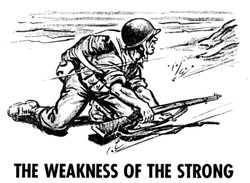 It is elementary that there can be no true economy of men's powers on the battlefield unless there is respect for the natural physical limitations of the average individual. But since it appears radical in that it undercuts the traditional belief that by encouraging men to think brave thoughts we can stimulate them to endeavors they scarcely dream of, some further illustration is required. It is provided by the experience of Company M, 116th Infantry, on the same day at Omaha Beachhead and in the same phase of the landing.
It is elementary that there can be no true economy of men's powers on the battlefield unless there is respect for the natural physical limitations of the average individual. But since it appears radical in that it undercuts the traditional belief that by encouraging men to think brave thoughts we can stimulate them to endeavors they scarcely dream of, some further illustration is required. It is provided by the experience of Company M, 116th Infantry, on the same day at Omaha Beachhead and in the same phase of the landing.
This company was an outstanding success. It started the day without heavy losses and with the unique accomplishment of getting all of its living members and all their equipment across the beach. The word "unique." means exactly that. No other infantry company at Omaha did that well in this particular.
By nightfall. Company M had completed the deepest advance within the regimental sector. That is the record. and the company needs no apologist. It can stand on what it did.
Company M's boat sections had expected to come ashore under cover of a rifle company. Had the plan worked out, they would have landed on an already won portion of the beach. But that wasn't the way it happened. The sections landed dry against a strip of coast still under control by the enemy and vigorously defended by fire from the heights. However, the sections were well collected when they debarked on the sand; the small boats had brought them in pretty much in line.
That, too, was unique good fortune among the assault forces at Omaha. It reacted on Company M like a moral tonic, largely offsetting the shock that came from the unexpected tactical situation. The company line paused very briefly at the water's edge—a pause not arising from indecision or need to rest the men. It was made so that the line could organize, and its members could look for routes through the belt of obstacles ahead and study the beaten zones where machinegun fire (there were six guns on them) was kicking up the sand beyond the belt of obstacles.
The company commander gave the order: "Carry everything to the shingle!" It was repeated from man to man. They started the advance with that intent and they made good.
Losing only a few men, Company M crossed the beach and gained the seawall. The manner of that advance is most interesting. They made it crawling. And it took them just ten minutes to get across the narrow beach. It had taken Company E, 16th Infantry, one hour, with the men walking only a few steps at a time.
The comparison is unfair because the moral, physical and tactical circumstances were totally unlike. But it is for the very reason that Company M, 116th, had a relatively successful experience in its first combat engagement, and that it continued to be an exceptionally aggressive unit on until the close of the war, that what its members said of their first advance is like a star shell illuminating an otherwise dark landscape.
Said Pfc. Hugo de Santis:
"We all knew we were carrying too much weight. It was pinning us down when the situation called for us to bound forward. The equipment had some of us whipped before we started. We would have either dropped it at the edge of the beach or remained there with it, if we had not been vigorously led."
Said Lieut. John S. Cooper:
"A few of the men were so weak from fear that they found it physically impossible to carry much more than their own weight. So the stronger men took the double risk of returning and helping the weaker men to move their stuff across the beach."
Said Serg. Bruce Heisley:
"We were all shaky and weak. I was that way though I had not been seasick during the ride in. In fact I didn't know my strength was gone until I hit the beach. I was carrying part of a machine gun. Normally I could run with it. I wanted to do so now but I found I couldn't even walk with it. I could barely lift it. So I crawled across the sand dragging it with me. I felt ashamed of my own weakness. But on looking around, I saw the others crawling and dragging the weights which they normally carried."
Said S/Sgt. Thomas B. Turner:
"We were all surprised to find that we had suddenly gone weak, and we were surprised to discover how much lire men can move through without getting hit. Under lire we learned what we had never been told—that fear and fatigue are about the same in their effect on an advance."
These were typical of many such statements made by men in the assault forces at Omaha. They help to explain the spectacle of hundreds of infantrymen stranded along the edge of the sands while the issue was being settled by a few relatively small bands which continued on to the high ground. The day was won by a small minority of those present, rallied by a few highly inspired leaders, prominent among them being Brig. Gen. "Dutch" Cota, who was already exploring the far side of the hill when his infantry companies came over the crest.
As for the men who couldn't get started, newspaper correspondents generously described them as "fighting grimly for a narrow strip of beach." By their own accounts, they were not "fighting grimly." They were dead beat and their formations had become stagnant. The substance of their testimony was that they lacked the physical strength the situation required.
Fear Equals Fatigue
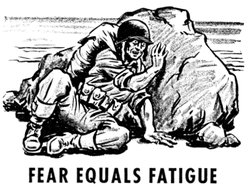 Reading the tactical notes from Omaha Beachhead, some might say that they prove only that we had not sufficiently hardened our men for war. But to drop it there makes all exploration of the case futile, since these troops were as well trained and conditioned as American troops are ever likely to be in the future. Also, as I have previously pointed out, training has it limits: it can never condition men to the accomplishment of battle tasks which are in excess of their natural physical capacities.
Reading the tactical notes from Omaha Beachhead, some might say that they prove only that we had not sufficiently hardened our men for war. But to drop it there makes all exploration of the case futile, since these troops were as well trained and conditioned as American troops are ever likely to be in the future. Also, as I have previously pointed out, training has it limits: it can never condition men to the accomplishment of battle tasks which are in excess of their natural physical capacities.
The real lesson is the one so clearly put by-Staff Sergeant Turner: "Fear and fatigue are the same in their effect on an advance." Nothing need be added to that and nothing taken away.
It is an objective statement of one of the most elementary truths of battle. Yet that truth has remained buried for centuries and it remained for an American enlisted man at Omaha Beach to say it for the first time in unequivocal language.
Whether you measure the matter by the standards of tactics or medicine, the result will be as stated. Fear and fatigue produce an immediate effect which appears to be identical. The man, whether tired or frightened, suffers a loss of muscular function and has a pervading feeling of physical weakness. The reduction of function as the consequence of fear is hence effectively the same as from physical fatigue. These facts, which were to be learned by observation of the forces of the battlefield, have more recently been confirmed in the laboratory. It can be shown that where there is chronic stress from fear over a considerable period, the physiological changes are comparable to those of fatigue. There is excessive action of the adrenal medulla and changes in the blood stream and muscle.
During the Central Pacific campaigns, two major generals, Archibald V. Arnold and Ralph C. Smith, were impressed by the phenomenon that if a skirmish line was halted two or three times during an attack by sudden enemy fire, it became impossible to get any further action from the men, even though none had been hurt. They asked me to determine why. The explanation, though not sensed clearly at the time, was that the attacking companies were being drained of their muscle power by the repeated impact of sudden fear. The store of glycogen in the muscles of the men was being burned up from this cause just as surely, though less efficiently, than if they were exhausting themselves in digging a line of entrenchments.
No appeal to spiritual forces can reverse these processes except in the measure that the appeal contributes to the relief of fear. It is as vain to believe otherwise as to think that mortals can be trained to remain absolutely unafraid in the face of death. In battle, whatever wears out the muscles reacts on the mind and whatever impairs the mind drains physical strength.
Tired men take fright more easily.
Frightened men swiftly tire.
The arrest of fear is as essential to the recovery of physical vigor by men as is rest to the body which has been spent by hard marching or hard work.
We are therefore dealing with a chain reaction. Half of control during battle comes of the commander's avoiding useless expenditure of the physical resources of his men while taking action to break the hold of fear. The other half of it comes from sensible preparation before hand.
When a man is tossed into combat carrying such weight that his shoulders ache and his knees shake, he has lost his main chance to conquer quickly his early fear, usually his worst. Through losing it, the probability is lessened that he will make a satisfactory early adjustment and become an efficient firer, and the chance is increased that he will become either a mental casualty or a combat goldbrick. From faulty appreciation of the logistical limits of the human carrier come the loss of tactical opportunity and the wastage of good manpower, since it is self-evident that nothing contributes more to the growth of lasting confidence in the soldier than having a successful experience his first time out in battle.
Seasonal Change
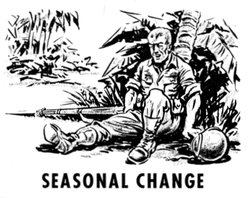 Battle shock, resulting from an excessive load on the soldier, is a far greater danger during summer operations than in normal winter operations when the cold is not intense enough to slow the muscle and chill the bone.
Battle shock, resulting from an excessive load on the soldier, is a far greater danger during summer operations than in normal winter operations when the cold is not intense enough to slow the muscle and chill the bone.
As a man becomes dehydrated during summer fighting, his courage flows out through his pores, along with his muscular strength. He loses his will to fight or to take constructive action. And the worst part of it is that he is not likely to understand that his sudden loss of will power and courage is because his physical strength has been sapped and that it may be within his power to check it.
Reduced to this condition, the soldier fails to dig a foxhole, even though he knows that he is in danger. The officer fails to properly inspect his position. Troops fail to reconnoiter the immediate area of their bivouac. Commanders hesitate to give orders and defer important decisions. This is not because the voices of conscience and reason don't tell them they are doing wrong, but because they lack the will to respond. In this state of slackness, the attitude of men becomes one of general indifference to the possible consequences of inaction.
Through such tests as Task Force Frigid, we have begun to survey the effects of excessively low temperatures upon the tactical efficiency of the average individual. But it has been known for fifty years that the soldier's muscle power is seriously impaired by hot weather. Near the close of the nineteenth century, tests were conducted by the "Institute William Frederick" in Germany to measure the effect on soldiers carrying various loads under varying conditions of temperature.
It was found that if the weather was brisk, a load of forty-eight pounds could be carried on a 15-mile march by seasoned men of military physique. But in warm weather the same load caused an impairment of physical powers and the man did not return to a normal state until some time during the day following the march.
When the load was increased to sixty-nine pounds, even when the weather was cool, the man showed pronounced distress. Furthermore, no amount of practice marching with this load made any change in the man's reactions. He continued always to show distress in about the same amount. The conclusion was therefore drawn that it is impossible to condition the average soldier to marching with this much weight no matter how much training he is given—a finding which flatly refutes the traditional view that a weight of about sixty-five pounds is a fair and proper load for a soldier.
During warm weather, under a load of sixty pounds, the man under test began to show physical distress almost immediately, and the loss of physical power, from marching with that weight, was measurable for several days afterward. This means in effect that even if a man could go into battle with no more nerves than a robot, the carrying of sixty pounds into a prolonged engagement would result ultimately in physical breakdown.
From the physical findings alone, the Institute concluded that forty-eight pounds per man was the absolute limit under the stress and fatigue of the combat field.
The William Frederick studies, in common with all other scientific inquiries into the physical effects of overloading, had the curious blind spot directing almost no attention to the fact that physical breakdown is accompanied in ratio by a decline in the mental and moral powers of men. Yet this is of extreme importance operationally, since it means that when mobility is lost because of physically exhausted troops, defensive protection is lost with it.
That is particularly the case during operations in excessive temperatures. Postwar exercises have shown us that men have zero mobility, and hence zero fighting power when the weather gets fifty degrees below zero. In hot-weather operations, dehydration is as great a danger to the soldier. It drains his whole physiological mechanism. When the all-important body salts are reduced to subnormal levels, the loss reacts directly on the nerve system and the brain. An otherwise courageous man may be turned into a creature incapable of making positive decisions or of contending against his own fears. lie is defeated by his own sweat. Any one who has suffered a slight case of heat prostration can attest to the feeling of helplessness which attends the victim. It becomes almost impossible to string words together coherently or to force one's self to take the simplest action.
I do not doubt that there has been many a case of apparent cowardice on the battlefield, wherein it was adjudged that the offense called for a firing squad, when what was really needed were a few salt tablets.
And if salt can be replaced, why not the other vital elements in body chemistry?
It would seem possible and practical that research could be directed toward the development of substances which might quickly correct the physiological changes from prolonged fear reaction.
Looking at tactics through the eyes of the physician, Col. Albert P. Clark, Medical Corps, said in 1941: "If I had the opportunity to select personally 5,000 men from the 48,000 in this area, and feed them a specially prepared diet which included increased vitamin and mineral content, I would have a small army of unbeatable men within six months. They would be men who would fight with rocks and their bare fists if they lost their weapons."
It is a challenging idea—that by better diet control we can build men up physically until they become relatively fearproof. But if there is substance to it, then it becomes not too wild a dream to expect that a "fear pill" may give a soldier increased mobility in the future—something which while not wholly eliminating fear, will slow down its nearing effect on the muscles.
The Load of War
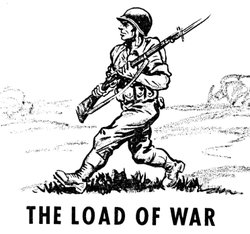 As with any other problem in war, it is easier to state the factors than to outline the general means of corerection. But at least several primary steps are indicated.
As with any other problem in war, it is easier to state the factors than to outline the general means of corerection. But at least several primary steps are indicated.
For one, it is necessary for the modern army to break away from the stubborn idea, dating from the Medes and the Persians, that what a soldier can carry on a hard road march during training is a fair measure of the load that he can manage efficiently when under fire. It simply isn't so. Once the fighting begins, we are dealing with a different man.
For another, it is necessary that we clear our thinking about what extra weight on the average man's back does to the forces of the battlefield. Von Moltke, that generous fellow who put 200 rounds of ammunition aboard the soldier, once remarked that, "An army which marches light will maneuver freely." It is a thought worthy of a schoolboy. While true enough, it is still nowhere near enough. If extra weight on the man had only the effect of hampering freedom of movement, we could afford it.
Its real curse on tactics is that it kills fire right at the fire base. It wastes soldiers who might otherwise be good fighting men. It kills men because it cheats the man of his best means of defense.
The third step is to set up in peacetime a system of absolute control which will make it impossible for any staff, once the firing begins to override common sense simply because it has overstrained its imagination.
That means training for weight-carrying, but arming for fleetness of foot.
It means having the courage to believe that the soldier with only five clips in his pocket but spring in his gait is tenfold stronger than the man who is foundered under the weight of ammunition he will never use.
It means schooling the soldier until he believes that a toughened back and strong legs will give him his main chance for survival, but at the same time schooling the command and staff to treat those firm muscles as the Army's most precious combat assets.
There may be an objection that this is easy to say but hard to do. The tremendous increase in the weight of material carried by the soldier over any earlier period is a much marked aspect of warfare today. So why speak of lightening the burden of the soldier when the tonnage figures rise higher even while you look at them?
The answer is that this has relatively little to do with the problem. We need only take one look at the over-all figures to make it immediately clear that the combat soldier can carry only a few of the things he needs to sustain him day after day. Actually the overall increase in the weight of war has less to do with the overburdening of the combat soldier than a general indifference toward his problem and the failure to afford him additional relief.
The records of the Makin operation, a part of the expedition into the Gilbert Islands in November 1943, have at least one unique entry. So far as I know, it was the only operation by American forces in World War II which was weighed out to the last pound, and is therefore the only source of a basic logistical figure for one man in combat.
Everything which was carried on the APAs for the immediate use of the battalion landing teams, as well as the combat tonnage in the auxiliary craft, the replace ment items and thirty days of maintenance for all services, was tabulated and computed. The total figures were then divided by the number of effectives.
The first set of figures covered materiel aboard the ships carrying the landing teams. It included individual and organizational equipment, organic weapons and vehicles, five units of fire for all weapons, C and E, rations for twelve days, medical supplies for ten days, seven days of gasoline per vehicle on board, and five gallons of water for each man.
When this cargo, all of which was needed to get the BLTs into combat on a reasonable minimum basis, was weighed out, it averaged 523 pounds per mun.
On the supply ships were B rations for twenty-four days, five gallons of water per man, thirty days of medical, engineering, quartermaster and signal supply, fifteen days of gasoline per vehicle in the BLTs, and thirty days of fuel supply for the LVTs, bulldozers and tractors. When this was added to the base load and averaged, the figure became 1,850 pounds per man.
The expedition was a little light on alligators and had only a few DUKWS. But its strength in armor was greater than that which normally supports an infantry regiment—one battalion had been added. When these weights—the tanks and amphibian craft—were added to the earlier totals and averaged, the expedition weighed 1,921.99 pounds per man.
Roughly then, we can say that it takes one ton of materiel to see one man through a thirty-day campaign. That is considerably less than the usual offhand estimate. But it is still such a weighty package that it is evident that what a man is required to carry into battle is not regulated by the necessity for relieving other types of carriers. Jeeps, weasels and alligators are landing right with him, ready to do the heavy work.
The fighting man could not even leave the boat or cross the line of departure if he had to carry everything needed to sustain him for one day of fighting.
It is this distinction which makes all of the difference between the problem of the modern army and that of the Roman legion, or for that matter, of the army that fought at San Juan Hill.
In our times, armies have mastered the problem of developing transport which directly feeds the line of fire.
There are instances without number from World War II of jeeps carrying ammunition to men who were under fire at ranges of less than 200 yards, and of weasels and half-tracks carrying supplies up to the OPL.
Probably in the future we will bring forth an even better jeep, with stronger traction and a lower silhouette. We will also improve the design of our amphibian craft, so that they are sturdier, more fire resistant and possessed of better road qualities.
But it is less important that we make technical improvements in our combat vehicles than that we commit them to the primary task of putting better legs under the soldier.
The Rule of Safety
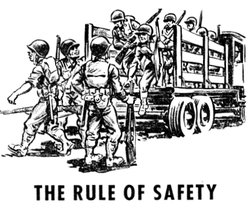 In War as I Knew It, Gen. George S. Patton, Jr., wrote: "No soldier should be compelled to walk until he actually enters battle. [From that point forward he should] carry nothing but what he wears, his ammunition, his rations and his toilet articles. [When the battle is concluded] he should get new uniforms, new everything."
In War as I Knew It, Gen. George S. Patton, Jr., wrote: "No soldier should be compelled to walk until he actually enters battle. [From that point forward he should] carry nothing but what he wears, his ammunition, his rations and his toilet articles. [When the battle is concluded] he should get new uniforms, new everything."
These are perfectly practical rules. The only amendment that might strengthen them would be to add that rations and ammunition should be specified only in the amounts which reason and experience tell us the soldier is likely to expend in one day. Beyond that, everything should he committed to first line transport. This includes entrenching tools since twenty heavy and sharp edged spades will give better protection any day to an entire company than 200 of the play shovels carried by soldiers. If we are dealing with mountain operations or any special situation where first line transport will have difficulty getting through, it is wiser to assign part of the troops temporarily to special duty as bearers and carriers, excusing them from fire responsibilities.
If we are ever to have a wholly mobile armv—mobile afoot as well as when motorized on the road—the fighting soldier should be expected to carry only the minimum of weapons and supplies which will give him personal protection and enable him to advance against the enemy in the immediate situation. He should not be loaded for tomorrow or the day after. He should not be "given an axe in case he may have to break down a door."
It is better to take the chance that soldiers will sleep cold for a night or two than to risk that they will become exhausted in battle from carrying too heavy a blanket load.
It is wiser to teach them to conserve food, how to live off the countryside, and the importance of equalizing the use of captured enemy stores that, it is to take the chance of encumbering them with an overload of rations.
It is sounder to teach them to worry less about personal hygiene and appearance during the hours in which they are fighting for their lives than to weight them down with extra changes of clothing.
It is more prudent to keep them light and thereby assist them to maintain juncture than to overload them with munitions and weapons in anticipation of the dire situations which might develop, should juncture be broken.
Most of our trouble arises from mistaken estimates of the minimum need. In training, we are overindulgent of the American soldier, and when we get ready to mount an operation, we are overfearful of what may happen to him. The result is that the very measures which are intended to effect an economy of men's powers help to destroy them. By continually taking counsel of our fears, we in fact transfer those fears to the brain of the front line fighter with every unnecessary pound which we load on his back.
Since in any great war of the future we will have to travel faster and farther than we have ever gone before, it is a good question whether the standard of individual mobility set by our troops during World War II will suffice, if we are to be victorious.
The possibilities of the kind of competition we may meet were outlined by Lieut. Gen. Sir Giffard Martel, who was chief of the British Military Mission to Russia during the most critical period of the late war.
He wrote: "The rank and file [of the Red Army] were magnificent from a physical point of view. Much of the equipment which we carry on vehicles accompanying the infantry are carried on the man's back in Russia. The Russians seem capable of carrying these great loads, They are exceptionally tough.
"Many of them arrived on September 6 and slept on the ground. It was bitterly cold and a little snow had fallen. The men had no blankets. But when we saw them on September 7 they were getting up and shaking themselves and seemed in good heart. Not a word was said about the cold. Two meals a day seemed to suffice for these troops."
This was the discipline to which Russian soldiers were being submitted during a training manoeuvre.
Of Human Nature
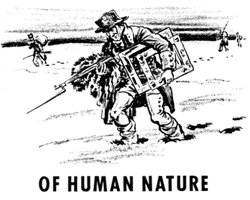 The average staff solution for the problem is to play it safe and load the soldier with everything he could possibly need.
The average staff solution for the problem is to play it safe and load the soldier with everything he could possibly need.
When you ask a high commander why we haven't found a better way, the only answer you commonly hear is that no real harm is done because, when the battle crisis comes, the soldier will use his common sense and discard those items he doesn't immediately need.
I hold that this idea is fallacious and as a basis for staff procedure it can be shown that it is directly counter to the interests of the Army.
The absence of reasonable and resolute standards, established during time of peace, means that our untried troops will have to start every war and every operation overloaded with unnecessary items of gear. They will pay an unnecessary price while they learn through trial-and-error what it takes to survive on the field of combat.
Even in peace, it is the unremitting obligation of the Army to look toward the possibility of war; in so doing, no goal can be more worthy than to strive to give the combat soldier the finest starting chance.
There may be room for difference of opinion about strategy but there should be none about what should be loaded on a soldier's back.
It should not be necessary to profit from the mistakes of a North Africa landing in order to do a little better when going into Sicily. A first battle well conducted, of which it can be observed that the lives of men were given every sensible safeguard consistent with the tactical problem, is the certain threshold to continuing fortune. But neither a first nor a last battle will be well conducted if its fundamental planning is based upon a false evaluation of the human element.
Surely that consideration is uppermost, or should be so, in our whole effort to mould character by means of military training. The more we pound the ideal of duty into men, the less becomes the chance that they will turn intensely practical the moment that danger threatens. This is particularly true of the first battle and of the earnest young soldier who has learned the rules but not the ways of an army, and who has visions of being stood before a court if he throws away his pup tent pins. The abandonment of his equipment, or any part thereof, under the pressure of fear must seem to him a flight from duty. For the time being, it is more likely to be the final step in his demoralization than the initial step toward his moral recovery.
Above all, battle is a test of manhood. When the mind becomes flooded with a fatal doubt of one's ability to do man's work, the doors are opened wide to personal failure. Disregard of this rather elementary fact was the cause of many of our combat fatigue cases.
The veteran soldier, on the other hand, becomes a realist after one of two baths of fire. He learns what isn't needed and he is no longer afraid to throw it away. He becomes willing to forage after, and carry along, those items of supply and fighting gear which are not provided by the tables, but which battle has proved to be highly useful to the unit's welfare and his personal progress.
It didn't take the majority of troops more than twenty four hours after landing on Normandy to overrule the high command's ideas of the need for gas protective equipment. It didn't take the average man long to dis cover that the issue trench knife had less practical value than a common sheath knife. The average young officer quickly learned that it was smart to throw away the abominable issue musette bag and substitute the easier-riding light pack. In the school of combat operations, the first great lesson is that the primary duty is to keep going and that one's conduct and conscience must be squared by this rule.
But there are definite limits to the realism even of the combat veteran. Being human, he is by nature acquisitive. He hoards his possessions and he is most loath to throw away anything which he personally prizes, whether it be a weapon for which he has a sentimental fondness (such as a Luger pistol or Samurai sword) or an undersize sweater knitted by loving hands at home.
Looting is a word not unknown in our Army. Though we still observe an official silence toward it, it is a tactical fact with which to reckon. Some commanders during World War II tended to systematize it, rather than ignore it, and so made it an incentive to troops.
There may be good moral grounds for doubting that it is possible thus to convert vice into virtue. But scruples aside, one had only to watch some of our regiments on the march to realize that if we are going to keep soldiers light on their feet in the future, we will have a hard choice to make. Either we will have to take absolute measures against looting, or else supply the Army with a moving conveyor belt which will carry this junk to the rear and post it on its way to the hallowed hearth of the American home.
Otherwise, what is likely to happen is best illustrated by the classic tale of Sergeant Bourgoyne, a member of Napoleon's army at Moscow.
When the army quit Moscow on October 19, 1812, Bourgoyne hefted his pack and decided that it was too heavy. So he examined its contents to see what he could discard. According to his Memoirs, he found "some pounds of sugar, some rice, some biscuits, a partly full bottle of liquor, a woman's Chinese dress embroidered in gold and silver, a bit of the cross of Ivan the Great, my own uniform, a woman's large riding cloak hazel-colored and lined with green velvet, two silver pictures in relief, one representing the judgment of Paris on Mount Ida and the other showing Neptune on a chariot, several lockets, and a Russian prince's spittoon set with brilliants."
But having found the pack too heavy, Bourgoyne could not get out of his mind the visions of the lovely women in Paris who might be seduced by some of these objects. So he did not lighten the pack. He went on his way for another month carrying his treasures. Then at the Battle of Krasnoe he lost everything, including his sixteen rounds of ammunition which he had been unable to fire because the weight of the prince's jewelled spittoon, and the other loot, had made him less than half a man.
There is something of Bourgoyne in the spirit of every soldier. Maybe some of us have less appetite for plunder. But in most of us there is the same reluctance to eschew pride of possession in the face of danger. We are rarely willing to strip down to the minimum military and personal essentials—which we must do if we are to fight and survive.
Under conditions of far greater stress, Maj. Robert K. Whiteley, Medical Corps, noted this trait in human nature as he witnessed the organization of the "Death March" from Mariveles to Camp O'Donnell in the Philippines on April 10, 1942.
There was virtually no leadership in the camp and each man had to think things out for himself. Most of the men were extremely weak from malaria and dysentery. They were told at the start that the march would be about 120 miles, and they were warned that those who fell out would he killed on the spot.
Said Whiteley: "I was surprised at the inability of average men to weigh the relative importance of things and discard every object which meant increased danger. Many started out carrying extra blankets, shirts, drawers and extra shoes. Some carried sewing kits, mirrors, framed pictures, clocks, flashlights and cameras. These weights put many of them in the ditch. They paid for the mistake with their lives." They were not the first soldiers to do this; nor, I fear, will they be the last.
In war, every march toward the enemy has essentially the same nature as the event witnessed by Whiteley, and every advance toward the enemy engages the same possible forfeit. The main chance for life and for successful action comes when that simple fact is recognized by the soldier and his superiors.
Toward Solution
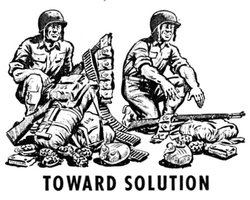 After studying this problem until it had digested nearly everything that history had to say about it, the British Commission which wrote The Load Carried by the Soldier, finally tossed in the sponge and failed to make any specific recommendations. It concluded with these words: "Everyone agrees that equipment must be lightened. But when it comes to saying what equipment can be dispensed with, there is endless variety of opinion. Aye, there's the rub."
After studying this problem until it had digested nearly everything that history had to say about it, the British Commission which wrote The Load Carried by the Soldier, finally tossed in the sponge and failed to make any specific recommendations. It concluded with these words: "Everyone agrees that equipment must be lightened. But when it comes to saying what equipment can be dispensed with, there is endless variety of opinion. Aye, there's the rub."
I simply dissent from any such fatal finding as this be cause I am convinced that the solution is already pointed up in the eminently practical terms of the battlefield. Let us by all means get at "the rub." There are several fundamental factors that argue for the elimination of excess equipment.
Point No. 1: There are the studies made by the Germans, British and others showing that the optimum marching load for the average man is not more than one-third of body weight.
Point No. 2: There are the proofs offered in this study (in which I feel the majority of combat men will concur) that men always experience a loss of muscular strength when moving against fire, and that they will therefore suffer a serious and unnecessary tactical impairment unless they go into battle packing less weight than they were conditioned to march with in training. If there is any lingering doubt that this loss of muscular strength is actual and acute let us think once more on our own combat experience; how much less exhausting it was to march away from the front than toward it, though there was no difference in the load!
Point No. 3: We have seen that we invariably carry more food, more munitions, more everything into combat than there is any reason to believe we will use.
These three points suggest a formula which is well within our reach, and without engaging in elaborate research on how to lighten the various items of issue.
We can get at it this way: According to the Quartermaster Corps, the average American soldier is 5 feet 8.3 inches tall, and weighs 153.6 pounds. This means that at one-third of body weight, his optimum load for marching during the training period (including the clothing he wears) is slightly more than fifty-one pounds.
If that load were increased to fifty-five pounds during training marches, he probably wouldn't be hurt. But on the other hand, it would contribute nothing toward toughening him physically. Furthermore, it is possible to keep within fifty-one pounds and still permit him to carry his combat essentials as well as two blankets and a raincoat. So there is no material justification for raising the load above that level during training.
But it is still necessary to work toward a lighter requirement for combat. Therefore, I have arbitrarily decided that the maximum combat load for the individual should never be more than four-fifths of the optimum training load. This eighty per cent figure has not been proved by any scientific fatigue tests; such tests would prove nothing because they could not simulate the conditions of combat. I grant that there are many men who would be able to carry more than that. Also, it would undoubtedly turn out that as men became experienced in combat and less susceptible to its nerve-shattering effects, they would become better conditioned to the carrying of heavier weights when it was required by a field emergency.
I arrived at the eighty per cent formula because it is within the area of the practical, and equally, because I feel strongly that the establishment of a maximum weight limit rule for combat and the steady adherence to it is far more important than any scientific debate about a few pounds more or less.
The optimum figure indicated for the working combat load is therefore forty to forty-one pounds per individual. We can do it, as is shown by the following table of weights. Though we had many variations of combat dress in World War II, according to the climate, the present field uniform strikes a good general average insofar as weight is concerned.
| Weight of Clothing | pounds |
| Field Uniform | 11.03 |
| Belt, cartridge, and 48 rds M1 ammo | 2.29 |
| Canteen, cover and cup, filled | 2.69 |
| first aid packet | .40 |
| Helmet w/liner | 2.82 |
| Rifle, M1 w/o bayonet w/sling | 10.30 |
| Two (2) grenades, fragmentation | 2.62 |
| Light pack w/(1) K ration and mess gear | 7.79 |
| Includes: | |
| Haversack and carrier | 2.46 |
| Toilet articles | .92 |
| Change of underwear | 43 |
| Two (2) pairs of socks | 38 |
| One (1) K ration | 2.31 |
| Mess gear | 1.29 |
| Total field uniform and battle equipment | .94 |
On that figure, I am prepared to stand. One blanket, woolen, OD, would add another four pounds; one rain coat, another three pounds. During initial combat in hot weather, it is better to take a chance without them than to put that much extra weight on men just as they are about to undergo fire for the first time.
I well recognize that the suggested changes are much easier said than accomplished. To say what the soldier should carry in battle to be able to fight and to remain mobile is the work of but a few minutes. But to weigh what has to be done by the Army to make possible such a reform requires consideration of almost every aspect of the Army's policy, including its training doctrine, its procurement program and its budget.
Certainly the reform could not be accomplished without a considerable increase in organic motor transport within the tactical unit. And though as a nation we have become motorized to the point where we have almost forgotten how to use our legs for walking, we have frequently deprived the Army of needed vehicles. And even when the door was wide open, the Army some times shorted itself. In the European Theater during World War II, there was hardly enough motor transport to go around. Sometimes, to remain mobile, we had to imitate Galliéni, and commandeer French taxicabs. When any great emergency threatened, as during the Ardennes operation, the rear area communications system had to be drained of every available truck in order to get our front-line elements moved to the decisive area in time. We were as short of a motor power reserve as we were of an infantry reserve.
But while there may be a ceiling on our ability to provide more motorization, we should remember that an increase of organic transportation does not mean, necessarily, an over-all increase for the general Army establishment. We can get greater work out of smaller forces when all men who fight are administered on a basis of absolute logistical efficiency. I repeat that 5,000 resolute and physically conditioned men will hit twice as hard and therefore travel twice as far when they are sent into battle with a reasonable working load as 15,000 men, the majority of whom have been whipped before crossing the starting line by the weight they are carrying. It is necessary to believe that absolutely. We cannot afford any more spectacles like Omaha Beachhead where we prevailed only because of the superhuman valor of a relatively few men.
Whenever great masses of troops become demoralized, it is twice as difficult for the bravest among the brave to become self-starters. We should not have to depend on the mathematical possibility that a few extra-hardy individuals will always be present, and will enable us to avoid tactical stagnation. To do so is to ask too much of the law of averages.
The Meaning of Mobility
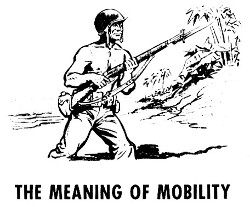 In closing I would say that we need mobility most of all on the battlefield. Swift and agile movement, rapidity and assurance of thought are the true essentials.
In closing I would say that we need mobility most of all on the battlefield. Swift and agile movement, rapidity and assurance of thought are the true essentials.
To get it, we must encourage every means of producing stronger and more accurate fire. fire is the stuff that wins and there is no substitute for it.
We will not have swift and agile movement, rapidity and assurance of thought—nor even stronger and accurate fire—as long as we cling to the superstition that under danger men can be expected to have more than their normal powers, and that they will outdo their best efforts simply because their lives are at stake. This form of ignorance leads only to needless brutality to our own combat troops— the men we can least afford to hurt.
To attain the desired end each of us should recall to our minds the American soldier as we have seen him at his best on the battlefield: on the fields of Brittany in the heat of summer, his sleeves rolled to the elbow, his shirt from open and his collar rolled in, responding to the primitive urge to strip to the limit because there is a light ahead; on the atolls of the Pacific, frequently bare to the waist and with his duty belt almost empty, although the enemy was only a hundred or so yards away; in the Argonne Forest, thirty years ago, throwing his pack and overcoat away despite the wintry cold, because the order was to go forward and he had learned to travel light.
Our Army was not assured mobility by the development of mechanization and motorization, though many of us mistakenly think so when we point to such achievements in the last war as the campaign of Western Germany where we put full armies over 600 miles of road in thirty days.
That was a phenomenal campaign, and I would not minimize it by pointing out that battles are not won on the road unless one is fighting an unequal opponent. Imperfect though it was in some particulars, the Army of the United States in World War II was still the most skillfully fashioned military mechanism of all time; it was more than good enough to merit the continuing confidence of our people. It demonstrated a degree of strategic mobility never before known in military forces. It mastered the mechanics of its trade.
But the significance of the achievement should not be exaggerated. We must learn to do as well with men as we have with machines. Up to the zone where men come under fire, ninety per cent of the problem of movement can be solved with the horsepower of our machines. From that line forward, ninety per cent of success depends on will power. The development of tactical mobility is almost wholly in the realm of the human spirit, since battle remains the freest of all free enterprises. Inwardly the fighting man has not greatly changed since the time of the Greeks and Romans. Whether he moves forward or hesitates in the moment when his life is at stake is almost wholly dependent on how well he has been led. Superior movement on the battlefield is the result of good leadership. The ability to command the loyalties of your men, to learn to think rapidly and resolutely in their behalf while teaching them to do likewise, and to strive always to avoid wasting their force and energy so that it may be applied in strength at the vital time and place—that is leadership of the highest possible caliber.
It is difficult for us to nourish this ancient truth while living in a machine civilization. It becomes very easy for us to play with the idea that we can build superior military power out of superlatively good industrial power.
But if we continue to slight the importance of the human element, that becomes no more possible than it was in the days of the handloom and spinning wheel. The real stuff of fighting mobility is not to be found in the troop carrier, the airplane and the tank. It remains where it has ever been—in the heart, muscle and brain of the average soldier.
The most perfect tank, airplane or self-propelled gun ever built has no mobile characteristics or offensive power on the battlefield until it comes under the control of a willing man. And willing men do not arise automatically simply because a nation has learned how to produce more efficient machinery.
The best brains of our scientists and engineers cannot alter these simple facts. Our production lines can turn out materiel until hell won't have it, and we still will not have solved the age-old mystery. Mobility in war will remain in man, in his fundamental loyalty, in the vision and intelligence which enable him to see opportunity and in the sense of duty which compels him to grasp it quickly and efficiently.
In the first great battle of the modern age of mobility—Cambrai in 1917—the British missed their cast for a great victory largely because of the overloading of the soldier.
When the order came to advance, the British tanks churned forward and cracked the German position. The infantry followed. But after four or five miles, the men collapsed from utter exhaustion, and the gap between infantry and armor could not be closed in time to keep the enemy from reorganizing.
The last great battle of the age can be lost in the same way unless there is due regard for the lesson.
- The O'Leary Collection; Medals of The Royal Canadian Regiment.
- Researching Canadian Soldiers of the First World War
- Researching The Royal Canadian Regiment
- The RCR in the First World War
- Badges of The RCR
- The Senior Subaltern
- The Minute Book (blog)
- Rogue Papers
- Tactical Primers
- The Regimental Library
- Battle Honours
- Perpetuation of the CEF
- A Miscellany
- Quotes
- The Frontenac Times
- Site Map
QUICK LINKS
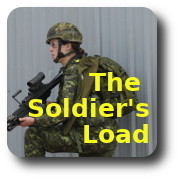
- The Service Kit of the Infantry Soldier (1901)
- The Load Carried by the Soldier (1921)
- The Equipment of the Infantry Soldier In the Light of War Experience (1923)
- The Mobility of One Man (1949)
- Keep The Doughboy Lightly Loaded (1950)
- The Soldier's Load (1955)
- The Accoutrements of the British Infantryman, 1640 To 1940
- A Soldier's Load (1987)
- The Soldier's Load; Planning Smart (1990)
- Soldier Load; When Technology Fails (1987)
- Load Carrying Ability (1990)
- Roadmarching and Performance (1990)
Soldier's Load posts on The Minute Book (blog)
- Soldiers Load (Canadian Militia, 1870)
- The Soldier's Load — The RCR at Vimy Ridge
- FSPB 1914 — Dismounted Soldiers
- Germany 1900-1914
- The Lewis Gun Section (1925)
- Platoon Weapons and Ammunition (1942)
- A historic problem
- The Soldier's Load (1871)
- A Soldier's Load
- The Infantry Platoon; 1942
- Dress and Equipment (1918)
- Soldier's Load; North Africa
- The Soldier's Load; Vietnam
- Factors Causing Soldiers' Overload
- The Soldiers Load; Australia
- The Soldier's Load in Vietnam
- Soldiers' Load — US Army — 1916
- Burden Put on Doughboy
- Sending Men to Death by Overloading
- To Test New Equipment (US Army, 1911)
- Exhaustible Infantry
- What a Soldier Carries
- The Burden the Soldier Boy Carries (1918)
- Japanese Soldier's Load (1910)
- Heaviest Laden Pack Animal in American Army
- Soldier's Kit in South Africa
- [US] Army Tries to Reduce Pack Weight (1963)
- The Soldier's Kit (1932)
- With a 70-Pound Pack (US Army, 1925)
- The Soldier's Load, Canadian Militia (1868)
- Commando Arms and Equipment